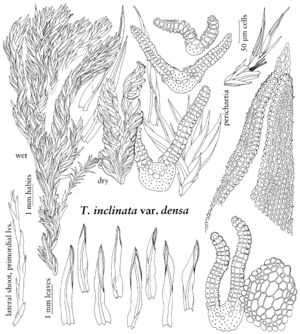Tortella inclinata var. densa
Laubm. Deutschl. 1: 604. 1888,.
Stems dull and often strongly orange-green, orange, or dull green distally and brownish black proximally, orange in KOH, to 2 cm, many-branched, tomentum hidden in leaf axils. Leaves when dry somewhat uniformly twisted on the stem (funaliform), erect proximally; leaf apices cucullate, acute, to narrowly acuminate, mucro of 5–7 cells; in cross section with thick abaxial and adaxial superficial walls, but thin cross-walls; papillae appearing pedestaled on thick walls, leaf cells 7–10 µm.
Habitat: Sandy soil of rocky uplands or hills, rock slides, soil at the base of sandstone outcrops, cliff crevices, ledges and bases in mesic to moist stations, associated with old post-glacial alluvium in drainage basins of lakes and rivers
Elevation: moderate elevations (900-1600 m)
Distribution

B.C., N.W.T., Alaska, Mich., Vt., Wis., Europe.
Discussion
Variety densa is apparently associated with older, stable habitats, rather than colonizing relatively more recent ones, as does var. inclinata. The stems are reddish orange, the leaves are densely foliose, and in cross section they have thickened superficial cell walls on both sides of the leaf section, forming pedestals on which the papillae are developed. Most of the leaves are acuminate, rather than cucullate, perhaps because the stems are richly perichaetiate. As the two reports of Tortella inclinata from arctic North America are var. densa, var. inclinata is considered here to be absent from that region. The most striking characteristic of western North American specimens from rocky substrates is their tall, densely foliose, numerously branched stems in regimented tufts, unlike var. inclinata, with stems usually smaller and indistinct, little branched, and leaves more chaotically twisted around the stem and half buried in the debris. The western specimens have darker (fuscous to black proximally) or more highly colored (orange) aspect, stiffer leaves, many or most narrowly acute yet still inrolled such that a subcucullate aspect to the leaf apex could be identified, a relatively orderly ropelike disposition of the leaves on dry stems, and peculiar distinctly thickened superficial cell walls.
Selected References
None.
